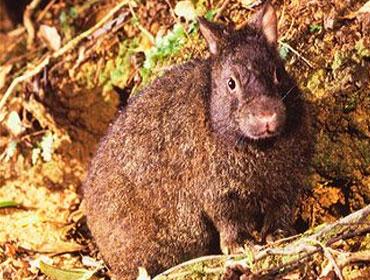 Amami Rabbit Amami RabbitPentalagus
furnessi (aka Ryuku Rabbit)
Description
The most primitive lagomorph in
the world, almost everything about the Amami
Rabbit is distinctive. Its thick, dark brown or
black fur fades to reddish brown on the sides and
underbelly. It has short ears, small eyes, long
curved claws, short legs, pointed nose, and a
very small tail.
Amami rabbits are 15-21 inches
long and weigh 4-7 pounds. Females are generally
slightly larger than males.
Distribution and
Habitat
This species is only found on
the Amami and Tokuno islands of the Nansei
archipelago, off the southwestern coast of Japan.
It lives in both new and old growth
forests and has also been found in some grassland
habitats consisting of ferns and perennials.
Reproduction
Amami rabbits may be promiscuous because the
male home ranges overlap with the female home
ranges. It is not known whether a single male
mates with more than one female, if a female
mates with more than one male, or if they both
mate with more than one partner.
The gestation period is unknown. It is
believed that only young is born per litter, but
there may be two litters in a year. The mother
gives birth in a burrow, and the young are left
in the burrow for up to two days at a time while
the mother forages for food. Age at weaning is
not known, but the mother will prevent her young
from returning "home" after three to
four months.
Diet
Grasses and ferns appear to make up most of
the diet, but nuts, berries, acorns, bark, and
leaves are also taken.
Other Habits and
Behaviors
Amami rabbits are difficult to study in the
wild because they are nocturnal, remaining in
their burrows during the day and foraging during
the night. They use passages in the undergrowth
to move around the forest. When approached, they
flee into nearby vegetation.
Swimming has been observed in this species,
but the frequency of their swimming behavior is
unknown.
Home ranges of males overlap with other males
and females, but the home ranges of females do
not overlap the home ranges of other females.
This rabbit communicates with auditory
signals, mainly vocalizations and sounds made by
pounding their hind limbs against the ground.
Conservation Status
The Amami Rabbit is listed as
endangered due to its limited native range. The current
population size is estimated at 2,000 to 4,800 on
Amami Island and 120 to 300 on Tokuno Island.
Scientific
Classification
phylum Chordata
subphylum Vertebrata
class Mammalia
order Lagomorpha
family Leporidae
genus & species Pentalagus furnessi

Animal Diversity Web http://animaldiversity.org/accounts/Pentalagus_furnessi/
Questions or comments about
this page?
|



